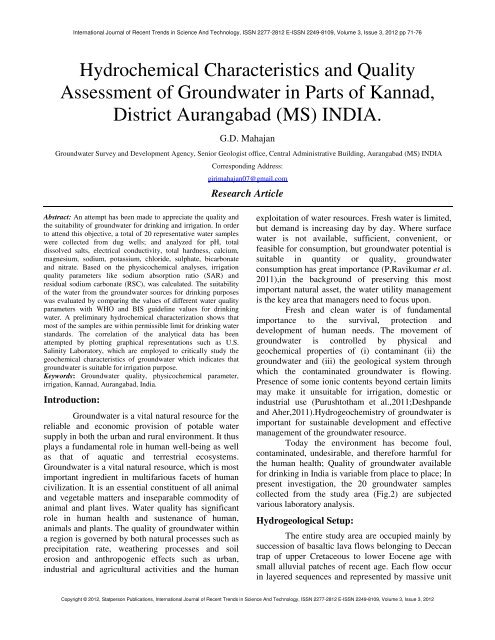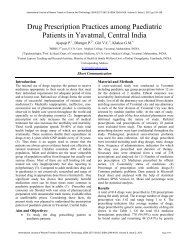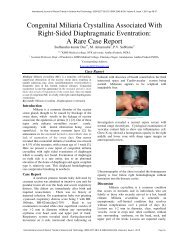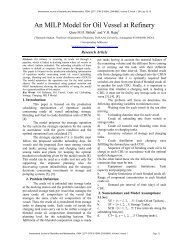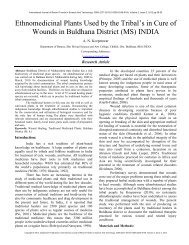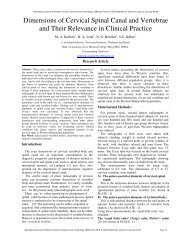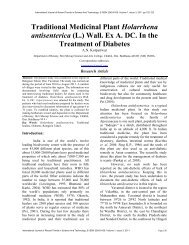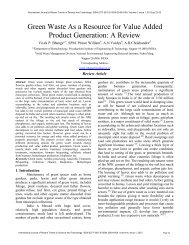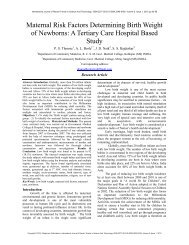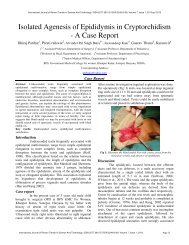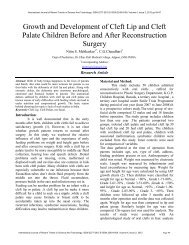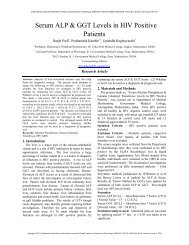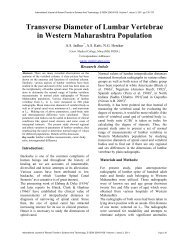PDF - Statperson
PDF - Statperson
PDF - Statperson
Create successful ePaper yourself
Turn your PDF publications into a flip-book with our unique Google optimized e-Paper software.
International Journal of Recent Trends in Science And Technology, ISSN 2277-2812 E-ISSN 2249-8109, Volume 3, Issue 3, 2012 pp 71-76<br />
Hydrochemical Characteristics and Quality<br />
Assessment of Groundwater in Parts of Kannad,<br />
District Aurangabad (MS) INDIA.<br />
G.D. Mahajan<br />
Groundwater Survey and Development Agency, Senior Geologist office, Central Administrative Building, Aurangabad (MS) INDIA<br />
Corresponding Address:<br />
girimahajan07@gmail.com<br />
Research Article<br />
Abstract: An attempt has been made to appreciate the quality and<br />
the suitability of groundwater for drinking and irrigation. In order<br />
to attend this objective, a total of 20 representative water samples<br />
were collected from dug wells; and analyzed for pH, total<br />
dissolved salts, electrical conductivity, total hardness, calcium,<br />
magnesium, sodium, potassium, chloride, sulphate, bicarbonate<br />
and nitrate. Based on the physicochemical analyses, irrigation<br />
quality parameters like sodium absorption ratio (SAR) and<br />
residual sodium carbonate (RSC), was calculated. The suitability<br />
of the water from the groundwater sources for drinking purposes<br />
was evaluated by comparing the values of different water quality<br />
parameters with WHO and BIS guideline values for drinking<br />
water. A preliminary hydrochemical characterization shows that<br />
most of the samples are within permissible limit for drinking water<br />
standards. The correlation of the analytical data has been<br />
attempted by plotting graphical representations such as U.S.<br />
Salinity Laboratory, which are employed to critically study the<br />
geochemical characteristics of groundwater which indicates that<br />
groundwater is suitable for irrigation purpose.<br />
Keywords: Groundwater quality, physicochemical parameter,<br />
irrigation, Kannad, Aurangabad, India.<br />
Introduction:<br />
Groundwater is a vital natural resource for the<br />
reliable and economic provision of potable water<br />
supply in both the urban and rural environment. It thus<br />
plays a fundamental role in human well-being as well<br />
as that of aquatic and terrestrial ecosystems.<br />
Groundwater is a vital natural resource, which is most<br />
important ingredient in multifarious facets of human<br />
civilization. It is an essential constituent of all animal<br />
and vegetable matters and inseparable commodity of<br />
animal and plant lives. Water quality has significant<br />
role in human health and sustenance of human,<br />
animals and plants. The quality of groundwater within<br />
a region is governed by both natural processes such as<br />
precipitation rate, weathering processes and soil<br />
erosion and anthropogenic effects such as urban,<br />
industrial and agricultural activities and the human<br />
exploitation of water resources. Fresh water is limited,<br />
but demand is increasing day by day. Where surface<br />
water is not available, sufficient, convenient, or<br />
feasible for consumption, but groundwater potential is<br />
suitable in quantity or quality, groundwater<br />
consumption has great importance (P.Ravikumar et al.<br />
2011),in the background of preserving this most<br />
important natural asset, the water utility management<br />
is the key area that managers need to focus upon.<br />
Fresh and clean water is of fundamental<br />
importance to the survival, protection and<br />
development of human needs. The movement of<br />
groundwater is controlled by physical and<br />
geochemical properties of (i) contaminant (ii) the<br />
groundwater and (iii) the geological system through<br />
which the contaminated groundwater is flowing.<br />
Presence of some ionic contents beyond certain limits<br />
may make it unsuitable for irrigation, domestic or<br />
industrial use (Purushtotham et al.,2011;Deshpande<br />
and Aher,2011).Hydrogeochemistry of groundwater is<br />
important for sustainable development and effective<br />
management of the groundwater resource.<br />
Today the environment has become foul,<br />
contaminated, undesirable, and therefore harmful for<br />
the human health; Quality of groundwater available<br />
for drinking in India is variable from place to place; In<br />
present investigation, the 20 groundwater samples<br />
collected from the study area (Fig.2) are subjected<br />
various laboratory analysis.<br />
Hydrogeological Setup:<br />
The entire study area are occupied mainly by<br />
succession of basaltic lava flows belonging to Deccan<br />
trap of upper Cretaceous to lower Eocene age with<br />
small alluvial patches of recent age. Each flow occur<br />
in layered sequences and represented by massive unit<br />
Copyright © 2012, <strong>Statperson</strong> Publications, International Journal of Recent Trends in Science And Technology, ISSN 2277-2812 E-ISSN 2249-8109, Volume 3, Issue 3, 2012
G.D. Mahajan<br />
at the bottom and vesicular unit at the top of the flow<br />
and is separated by the occurrence of red bole which<br />
shows time gap between flows. The main water<br />
bearing formations of the study area are weathered<br />
zeolitic basalts as well as weathered fractured and<br />
jointed massive basalt. Due to presence of alternate<br />
units of vesicular and massive basalt, it acts as multiaquifer<br />
system. The soil of the study area is mostly<br />
formed from igneous rocks and are black, medium<br />
black, shallow and calcareous types having different<br />
depths and profiles.<br />
Methods of Investigation:<br />
Twenty groundwater samples from different<br />
villages of the study area were collected and analyzed<br />
for major parameters (Table.2).The samples were<br />
collected in pre cleaned polyethylene containers of<br />
one liter capacity. The samples were collected from<br />
those wells only which are extensively used for<br />
drinking and irrigational purposes. Field samples were<br />
analyzed immediately (APHA, 1992) for hydrogen ion<br />
concentration (pH) and electrical conductivity (EC),<br />
using pH and EC meters and other parameters were<br />
analyzed immediately in the lab as per the standard<br />
methods for examination of water and wastewater<br />
(APHA, 1991) and Trivedi and Goel (1984).all results<br />
are compared with standard limit recommended by the<br />
(BIS,1991) and (WHO,1993).<br />
Result and Discussion:<br />
Groundwater quality for drinking purpose<br />
The pH values of groundwater ranged from<br />
7.4 to 8.1 with an average value 7.75. This shows that<br />
the groundwater of the study area is mainly alkaline in<br />
nature and all the samples are within the permissible<br />
limit prescribed by BIS (1991), (Table.2). The value<br />
of EC varied from 321 µmhos/cm to 2221 µmhos /cm<br />
with an average value of 988.6 µmhos/cm. The<br />
maximum limit of EC in drinking water is prescribed<br />
as 1500 µmhos /cm as per WHO (1993) standard. 4<br />
samples (20%) were exceeds the permissible limit.<br />
Electrical conductivity is an indication of the<br />
concentration of total dissolved solids and major ions<br />
in a given water body (Deshpande and Aher, 2012).<br />
The TDS value ranged from 207 to 1567 mg/L with a<br />
mean of 654 mg/L. The BIS specifies a desirable total<br />
dissolved solids limit of 500mg/L and a maximum<br />
permissible limit of 2,000mg/L, and study area shows<br />
12 samples (60%) are below desirable limit and 8<br />
samples (40%) were exceeding desirable limit but<br />
below permissible limit (Table.1). Water with high<br />
total dissolved solids generally is inferior palatability.<br />
The presence of calcium (Ca 2+ ) in drinking water is<br />
natural geological source and agricultural wastes.<br />
Calcium (Ca 2+ ) values ranged from 16 to 113 mg/L<br />
with an average value of 59.2 mg/L, the desirable<br />
limit of Calcium (Ca) for drinking water is specified<br />
by BIS (1991) as 75 mg/L and a maximum<br />
permissible limit of 200 mg/L. It is observed that 15<br />
samples (75%) are below desirable limit and 5<br />
samples (25%) were exceeding desirable limit but<br />
below permissible limit as prescribed by BIS (1991)<br />
(Table.1). Magnesium (Mg 2+ ) concentration varies<br />
from 15 mg/L to 98 mg/L with mean values of 38<br />
mg/L (Table.2). According to BIS (1991) the desirable<br />
values of Mg 2+ is 30 mg/L and a maximum<br />
permissible limit of 100 mg/L, where 8 samples (40%)<br />
below desirable limit and 12 samples (60%) samples<br />
were exceeding desirable limit but within the<br />
maximum permissible limit (Table.1). A total<br />
hardness value varies from 92 to 590 mg/l with a<br />
mean values 294 mg/L. The desirable limit of total<br />
hardness (TH) for drinking water is specified by BIS<br />
(1991) as 300 mg/L and a maximum permissible limit<br />
of 600 mg/L. It is observed that 11 samples (55%)<br />
below desirable limit and 9 samples (45%) samples<br />
were exceeding desirable limit but within the<br />
maximum permissible limit (Table1). Sodium (Na + )<br />
and Potassium (K + ) are present in a number of<br />
minerals. Sodium (Na + ) and Potassium (K + ) values<br />
ranged from 22 to 120 mg/L and 1 to 4 mg/L with an<br />
average value of 51.1 to 1.7 mg/L respectively<br />
(Table.2). Alkalinity is the measure of the capacity of<br />
the water to neutralize a strong acid. The Alkalinity in<br />
the water is generally imparted by the salts of<br />
carbonates, silicates, etc. together with the hydroxyl<br />
ions in free state, the bicarbonate alkalinity (HCO − 3 )<br />
varies from 52 to 443 mg/L with an average value of<br />
219.5 mg/L (Table.2). The Chloride (Cl − ) ion<br />
concentration varied between 43 to 230 mg/L with a<br />
mean values 99.7 mg/L. It is observed that all the<br />
samples are below desirable limit prescribed by BIS<br />
(1991) (Table.2). The nitrate (NO − 3 ) in the study area<br />
varies from 10 mg/L to 67 mg/L (Table 1) and all<br />
samples are within the permissible limit (>45)<br />
prescribed by WHO (1993) and BIS (1991). Nitrogen<br />
in groundwater is mainly derived from organic<br />
industrial effluents, fertilizer or nitrogen fixing<br />
bacteria, leaching of animal dung, sewage and septic<br />
tanks through soil and water matrix to groundwater<br />
(Richard, 1954; Reddy, et al, 2012). Sulphate (SO 2- 4 )<br />
International Journal of Recent Trends in Science And Technology, ISSN 2277-2812 E-ISSN 2249-8109, Volume 3, Issue 3, 2012
International Journal of Recent Trends in Science And Technology, ISSN 2277-2812 E-ISSN 2249-8109, Volume 3, Issue 3, 2012 pp 71-76<br />
content in groundwater is made possible through<br />
oxidation, precipitation, solution and concentration, as<br />
the water traverses through rocks. The (SO 4 2- ) values<br />
of groundwater ranged from 11 to 151 mg/L with an<br />
average value 60.5 mg/L (Table.2).<br />
Groundwater quality for irrigation purpose<br />
The water used for irrigation is an important factor in<br />
productivity of crop, its yield and quality of irrigated<br />
crops. The quality of irrigation water depends<br />
primarily on the presence of dissolved salts and their<br />
concentrations. Sodium absorption Ratio (SAR) and<br />
Residual Sodium Carbonate (RSC) are the most<br />
important quality criteria, which influence the water<br />
quality and its suitability for irrigation.<br />
Sodium absorption Ratio (SAR)<br />
The sodium hazard is typically expressed as the<br />
sodium adsorption ratio (SAR). Sodium adsorption<br />
ratio varied from 0.9 to 3.4 (Table 2). Todd (1980)<br />
classified irrigation water with SAR values less than<br />
10 as excellent and the water is evaluated suitable for<br />
any crop Lower the ionic strength of Sodium, greater<br />
the sodium hazard; and conversely, if Calcium and<br />
magnesium predominant, the hazard is low, SAR<br />
values 10-18 are good, 18 to 26 are fair and about 26<br />
are said to be unsuitable for irrigation (USDA, 1954,<br />
Aher and Deshapnde, 2011). The sodium adsorption<br />
ratio values for each water sample were calculated by<br />
using equation given by Richard (1954). Sodium<br />
adsorption ratios for groundwater samples of the study<br />
are less than 10 indicate excellent quality for<br />
irrigation. There is a significant relationship between<br />
SAR values of irrigation water and the extent to which<br />
sodium is absorbed by the soil. If the water used for<br />
irrigation is high in Sodium and low in Calcium, the<br />
cation-exchange complex may become saturated with<br />
Sodium (Tatawat and Singh Chandel, 2007). The US<br />
salinity Laboratory of the Department of Agriculture<br />
adopted certain techniques based on which the<br />
suitability of water for agriculture is explained. The<br />
correlation between sodium-absorption ratio and<br />
electrical conductivity was plotted on the US salinity<br />
diagram, in which EC is taken as salinity hazard and<br />
SAR is taken as alkalinity hazard. The plots of<br />
groundwater chemistry of study area in USSL diagram<br />
are shown (Fig.1) and it was found that 55 % of<br />
samples fall in the field of C 2 -S 1 indicating medium<br />
salinity and low alkalinity hazard, 45 % of the<br />
samples fall in the field of C 3 -S 1 , indicating water of<br />
high salinity and low sodium, which can be used for<br />
irrigation in almost all types of soil.<br />
Copyright © 2012, <strong>Statperson</strong> Publications, International Journal of Recent Trends in Science And Technology, ISSN 2277-2812 E-ISSN 2249-8109, Volume 3, Issue 3, 2012
G.D. Mahajan<br />
Residual Sodium Carbonate (RSC)<br />
In water having high concentration of<br />
bicarbonates, there is tendency for calcium and<br />
magnesium to precipitate as carbonates. To qualify<br />
this effect, an experimental parameter termed as<br />
residual sodium carbonate can be calculated.<br />
According to the US Department of Agriculture, water<br />
having less than 1.25 or equal to 1.25 epm of RSC is<br />
safe water for irrigation purpose, water is having less<br />
than 1.25 to 2.5 epm of RSC is marginally suitable for<br />
irrigation purpose whereas water having more than 2.5<br />
epm of RSC is not suitable for irrigation purposes.<br />
Based on RSC values, all the samples of study area<br />
had values less than 1.25 and were safe for irrigation.<br />
Conclusions:<br />
Hydrochemical parameter and quality<br />
assessment data of groundwater in parts of Kannad,<br />
was compared with BIS (1991) and WHO (1993)<br />
shows that groundwater of the study area is suitable<br />
for drinking purposes and public health. The values of<br />
sodium adsorption ratio (SAR) and residual sodium<br />
carbonate (RSC) are within permissible limit<br />
indicating groundwater is suitable for irrigation. The<br />
values of EC and SAR of groundwater samples have<br />
been plotted in U.S. salinity diagram indicating that<br />
55% samples fall in C 2 -S 1 and 45% samples falls in<br />
C 3 -S 1 category showing moderate to high salinity and<br />
low sodium hazard. Overall the groundwater quality<br />
of the study area is suitable for the domestic as well as<br />
irrigation purpose.<br />
References:<br />
[1] Aher K.R. and Deshpande S.M. (2011): Assessment of<br />
Water Quality of the Maniyad Reservoir of Parala<br />
Village, district Aurangabad: Suitability for<br />
Multipurpose Usage, Recent Trends in Science And<br />
Technology, Vol.1, (3), pp 91-95.<br />
[2] APHA (1992). Standard Methods for the Examination of<br />
Water and Waste Waters, American Public Health<br />
Association, 18th Edition, Washington, DC.<br />
[3] BIS (1991). Specifications for Drinking Water, IS:<br />
10500: 1991, Bureau of Indian Standards, New Delhi,<br />
India.<br />
[4] Deshpande S.M., and Aher, K.R. (2011). Quality<br />
Characterization of Groundwater of Tribakeswar-Peth<br />
area of the Nashik district and its Suitability for<br />
Domestic and Irrigation Purpose. Gondwana Geological<br />
Magzine, Vol. 26 (2).<br />
[5] Deshpande S.M.and Aher K.R.(2012):Evaluation of<br />
Groundwater Quality and its Suitability for Drinking<br />
and Agriculture use in Parts of Vaijapur, District<br />
Aurangabad, MS, India, Research Journal of Chemical<br />
Sciences, vol.2(1), pp 25-31.<br />
[6] Purushtotham, D., Rao, A.N., Ravi Prakash, M., Shakeel<br />
Ahmed and G. Ashok Babu (2011). Environmental<br />
impact on groundwater of Maheshwaram watershed,<br />
Ranga Reddy district, Andhra Pradesh, Jour. of<br />
Geological society of India, Vol. 77, pp 539.<br />
[7] P. Ravikumar., R. K. Somashekar, and Mhasizonuo<br />
Angami (2011). Hydrochemistry and evaluation of<br />
groundwater suitability for irrigation and drinking<br />
purposes in the Markandeya River basin, Belgaum<br />
District, Karnataka State, India, Environ Monit<br />
Assess,173:459–487, DOI 10.1007/s10661-010-1399-2<br />
[8] Reddy, L Chandra Sekhar., Deshpande, SM., Reddy,<br />
KV Ramana.,and Aher, KR (2012). Hydro Geochemical<br />
Processes in the Groundwater Environment of Vemula<br />
area, Kadapa District, South India, Recent Trends in<br />
Science and Technology, Vol. 3 ( 1), pp 18-24.<br />
[9] Richard, L.A. (1954): Diagnosis and improvement of<br />
Saline and Alkali Soils, Agric. Handbook 60, U.S. Dept.<br />
Agric., Washington, D.C., 160 pp<br />
[10] Tatawat, R. K.,and C.P. Singh Chandel (2007). Quality<br />
of ground water of Jaipur city and its suitability for<br />
domestic and irrigation purpose, Applied Ecology and<br />
Environmental Research vol. 6(2) pp 79-88.<br />
[11] Trivedi, R.K. and Goel,P.K.,(1984). Chemical and<br />
biological methods for water pollution studies.<br />
Environmental Publications Karad, India 215.<br />
[12] Todd, D.K. (1980): Ground water Hydrology, John<br />
Willey & sons publishers, New York<br />
[13] U.S. Department of Agriculture (USDA) (1954):<br />
Diagnosis and Improvement of Saline and Alkali Soils,<br />
Handbook 60. U.S. Department of Agriculture,<br />
Washington, D.C.<br />
[14] World health organization.(1993) Guidelines for<br />
drinking water. Vol.1. (pp. 52-82). Geneva.<br />
International Journal of Recent Trends in Science And Technology, ISSN 2277-2812 E-ISSN 2249-8109, Volume 3, Issue 3, 2012
International Journal of Recent Trends in Science And Technology, ISSN 2277-2812 E-ISSN 2249-8109, Volume 3, Issue 3, 2012 pp 71-76<br />
Fig.2. Location map of the study area<br />
Table.1 Quality of groundwater in parts of Kannad, district Aurangabad.<br />
Parameter Desirable limit Permissible limit DLMPL (%)<br />
TDS 500 2000 60 40 -<br />
Ca 2+ 75 200 75 25 -<br />
Mg 2+ 30 100 40 60 -<br />
Hardness 300 600 55 45 -<br />
Cl - 250 1000 100 - -<br />
−<br />
NO 3 45 100 70 30 -<br />
Copyright © 2012, <strong>Statperson</strong> Publications, International Journal of Recent Trends in Science And Technology, ISSN 2277-2812 E-ISSN 2249-8109, Volume 3, Issue 3, 2012
G.D. Mahajan<br />
Table.2 Analytical data from the groundwater and irrigational specification values of study area<br />
Sample No. pH<br />
EC TDS Na + K + Mg 2+ Ca 2+ TH<br />
-<br />
HCO 3<br />
2-<br />
SO 4 Cl - -<br />
NO 3<br />
(S cm -1 ) (mg/L) (mg/L) (mg/L) (mg/L) (mg/L) (mg/L) (mg/L) mg/L) (mg/L) (mg/L)<br />
SAR RSC<br />
1 7.4 806 520 35 1 38 66 310 301 32 65 40 1.20 -1.48<br />
2 7.8 1745 1120 120 1 50 109 450 335 70 230 55 3.38 -4.06<br />
3 7.9 1490 970 48 2 45 113 462 310 69 170 45 1.37 -4.26<br />
4 7.6 1651 1070 98 3 35 106 390 341 67 190 46 2.98 -2.58<br />
5 7.8 766 450 35 1 32 71 303 251 53 64 24 1.22 -2.06<br />
6 7.5 2113 1567 67 1 70 17 325 172 98 121 62 2.27 -3.77<br />
7 7.8 625 404 65 2 16 35 115 52 105 120 10 3.23 -2.21<br />
8 7.9 598 387 23 1 21 37 187 201 11 43 12 1.06 -0.28<br />
9 7.6 981 634 40 1 23 103 345 280 61 85 35 1.31 -2.45<br />
10 7.8 2221 1465 78 1 98 35 590 443 120 150 67 2.17 -2.52<br />
11 8.1 321 207 45 1 15 16 92 60 15 71 21 1.25 -3.58<br />
12 7.5 680 442 34 1 39 48 276 123 55 65 37 2.75 -1.05<br />
13 7.9 623 403 27 3 21 65 245 241 24 51 10 1.05 -1.02<br />
14 7.4 1040 676 53 1 31 91 321 276 151 85 52 1.73 -2.57<br />
15 8.1 321 207 45 1 15 16 92 60 15 71 21 2.75 -1.05<br />
16 7.79 711 462 43 2 41 45 285 202 42 92 44 1.58 -2.30<br />
17 7.6 661 423 23 3 24 71 267 161 37 61 41 0.85 -2.88<br />
18 7.7 490 321 22 1 23 37 195 133 41 43 34 0.99 -1.55<br />
19 7.9 710 462 47 4 42 46 284 201 46 91 44 1.71 -2.45<br />
20 7.8 655 423 34 2 37 46 261 192 57 52 41 1.28 -2.19<br />
Min. 7.4 321 207 22 1 15 16 92 52 11 43 10 0.9 -4.25<br />
Max. 8.1 2221 1567 120 4 98 113 590 443 151 230 67 3.4 -0.27<br />
Avg. 7.745 988.64 653.95 51.09 1.73 37.7 59.2 294.4 219.5 60.5 99.7 37.2 1.83 -2.31<br />
International Journal of Recent Trends in Science And Technology, ISSN 2277-2812 E-ISSN 2249-8109, Volume 3, Issue 3, 2012


